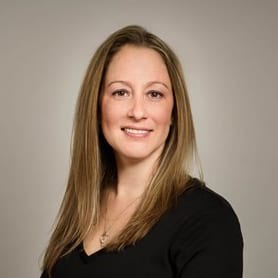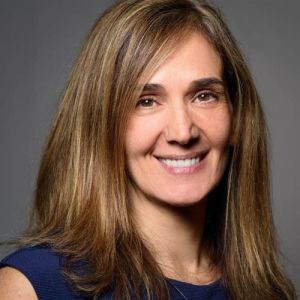Presented By: Future of Series presented by JPMorgan Chase
Strength of Industrial and Recovery of Multifamily: A JPMorgan Chase Review
By Future of Series presented by JPMorgan Chase April 19, 2021 8:00 am
reprints
Judy Guarino is a managing director for commercial mortgage lending at JPMorgan Chase, providing financing to retail, office and industrial investors in the metro New York market.
Brooke Richartz is an executive director for the firm’s multifamily lending team under commercial term lending, serving the metro New York area for multifamily apartment buildings.
Commercial Observer’s Partner Insights team spoke with Guarino and Richartz about how their sectors are faring now that the vaccine has brought the COVID-19 pandemic’s end in sight.
Commercial Observer Partner Insights: Given the vaccine rollout, talk about whether you’re starting to see improvements and optimism within your respective markets.

Brooke Richartz: On the multifamily side, we’re seeing our clients’ rent collections improve. In Manhattan, free-market rents had lower collections compared to rent-stabilized. But, even there, we’re starting to see leasing activity increase, and rent collections are improving as well.
Judy Guarino: We’re seeing a similar trend in commercial mortgage lending. It’s been improving since the second half of 2020. It also depends on the location. For instance, certain areas of Manhattan struggled more but, overall, there has been a steady improvement since last summer in all asset classes and property types.
Brooke, what trends have you seen in multifamily since the beginning of the year, especially as the vaccine has been rolling out?
Richartz: We’re seeing increased leasing activity in Manhattan, especially around universities. The feedback we’re hearing from landlords is that once schools open back up, rents are going to rebound pretty quickly. Luckily, we’re starting to see folks come back to the city and rent apartments again. Albeit with some concessions, one or two months’ worth, but, overall, the market’s improving.
JPMorgan Chase recently announced it’s putting $14 billion into affordable housing preservation and construction through a new initiative. Tell us about your efforts there.
Richartz: This is really exciting. JPMorgan Chase committed $30 billion to advance racial equity, particularly in Black and Latinx communities. For multifamily, we’re looking to help maintain affordable housing in the markets we lend in and committed to help finance approximately 100,000 units over the next five years. That’s in addition to what we’re doing with preserving apartments, since we’re also working on construction and rehab loans. There’s also some additional firm financing being done to support homeownership.
What effect do you think these efforts will have on the big picture of affordable housing in the regions where you work?
Richartz: It’s really strengthening these communities. If you think about how the average teacher in New York City starts out making an average of $57,845 a year, being able to preserve monthly rents of $1,500 versus $3,000 really improves their life and their ability to save money, and maybe buy a home one day. That’s the exciting story — helping the vital workforce in New York make it here.
Judy, industrial seems to be one of the few asset classes that’s done well over the past year. Talk about how it has fared in the regions where you work.

Guarino: It’s no surprise that industrial is one of the strongest asset classes. I’ll put it right up there with multifamily when it comes to investment opportunities. Prior to the pandemic, the industrial sector was very strong, due to increased e-commerce activity and demand for last-mile delivery, but there was a shortage of supply with industrial warehouse space in our market. During the pandemic, e-commerce activity increased drastically. While communities sheltered in place, online purchases became the primary source to shop.
One asset class, in particular, I see performing well is mixed-use. Mixed-use properties with rent-stabilized apartments above take-out fast food, pharmacy or other essential business, likely did well during the pandemic. It depended a lot on location. When you pass through Midtown, you have a different story because it’s mainly office, retail and tourism. That area was impacted more than the retail residential neighborhoods.
Has funding become easier or harder to arrange during the pandemic, and where does that stand now?
Guarino: In the beginning of shelter in place, we had to quickly learn how to close loans virtually. It took everyone working together with title companies, appraisers, and other partners to figure it out. Luckily, we didn’t miss a beat and have been able to provide financing to our clients throughout the pandemic.
Richartz: We have funded over $2 billion since the onset of the pandemic in March 2020. So, we’ve been pretty active in New York multifamily.
Has the pandemic influenced your thoughts on how JPMorgan Chase makes a positive difference in communities?
Judy Guarino: Yes. Communication has been key throughout the pandemic, and we have been there for our clients. We stayed closely connected with them to discuss how we can assist them and help them be there for their tenants. Through everything we went through, these partnerships were deepened, which helped support the communities where we live and work.
Richartz: It was heartwarming to see how our clients worked with their tenants, particularly with residential tenants who were struggling, because they may have lost their job or were otherwise impacted. There is a real human element to the way everyone was looking out and trying to help each other during all this uncertainty. There was a lot of outreach and compassion, while working with each other to get through the challenge.



